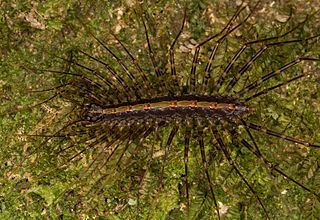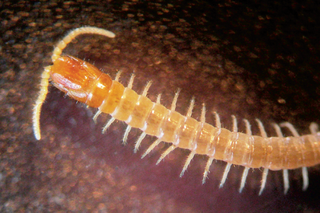
Pselliodidae is a family of small centipedes, identical and closely related to house centipedes.

Tygarrup is a genus of centipedes in the family Mecistocephalidae, found mainly in southeast Asia and from the Seychelles to Hawaii. Although species in this genus can have either 43 or 45 leg-bearing segments, most of these species have 45 leg pairs. An undescribed Tygarrup species found in the Andaman Islands has 43 leg pairs. Centipedes in this genus range from 2 cm to 6 cm in length. Tygarrup javanicus is one of the smallest of the mecistocephalid species and has become an invasive in greenhouses in Europe.
Zelanophilidae is a family of centipedes belonging to the order Geophilomorpha and superfamily Geophiloidea. Centipedes in this family are found in the Australasian region. The smallest species in this family, Tasmanophilus spenceri, measures only 23 mm in length and has only 39 pairs of legs, the minimum number recorded in this family. The largest species in this family, Australiophilus ferrugineus, can reach 120 mm in length and can have as many as 109 leg pairs. The species Australiophilus longissimus can reach 72 mm in length and can have as many as 117 leg pairs, the maximum number recorded in this family.
Steneurytion is a genus of centipedes in the family Geophilidae. It was first described by Austrian myriapodologist Carl Attems in 1909.
Pachymerinus australis is a species of centipede in the Geophilidae family. It is endemic to Australia, and was first described in 1920 by American biologist Ralph Vary Chamberlin.
Ribautia wheeleri is a species of centipede in the Geophilidae family. It is endemic to Australia, and was first described in 1920 by American biologist Ralph Vary Chamberlin.
Tasmanophilus is a genus of two species of centipedes, in the family Zelanophilidae. It was described by American biologist Ralph Vary Chamberlin in 1920. Centipedes in this genus are found in Australia and New Zealand.
Pachymerellus is a genus of two species of centipedes, in the family Geophilidae. It was described by American biologist Ralph Vary Chamberlin in 1920.
Pachymerellus zygethus is a species of centipede in the Geophilidae family. It is endemic to Australia, and was first described in 1920 by American biologist Ralph Vary Chamberlin.
Tuoba is a genus of 17 species of centipedes, in the family Geophilidae. It was described by American biologist Ralph Vary Chamberlin in 1920.
Zelanophilus is a genus of three species of centipedes, in the family Zelanophilidae. It was described by American biologist Ralph Vary Chamberlin in 1920.
Mecistocephalus is a genus of centipedes in the family Mecistocephalidae. It was described by British entomologist George Newport in 1843.
Mecistocephalus simplex is a species of centipede in the Mecistocephalidae family. It is endemic to Australia, and was first described in 1920 by American biologist Ralph Vary Chamberlin.
Anopsobius relictus is a species of centipede in the Henicopidae family. It is endemic to Australia. It was first described in 1920 by American biologist Ralph Vary Chamberlin.
Australobius scabrior is a species of centipede in the Lithobiidae family. It was first described in 1920 by American biologist Ralph Vary Chamberlin.
Cryptops lamprethus is a species of centipede in the Cryptopidae family. It is endemic to New Zealand. It was first described in 1920 by American biologist Ralph Vary Chamberlin.
Maoriella is a genus of centipedes in the family Geophilidae. It was described by Austrian myriapodologist Carl Attems in 1903. Species in this genus are found in New Zealand, Australia, and Tahiti.
Maoriella zelanica is a species of centipede in the Geophilidae family. It is endemic to New Zealand. It was first described in 1920 by American biologist Ralph Vary Chamberlin.
Gonethina is a genus of centipedes in the family Pselliodidae. It was described by American myriapodologist Ralph Vary Chamberlin in 1918.
Mecistocephalus erythroceps is a species of centipede in the Mecistocephalidae family. It was described in 1920 by American myriapodologist Ralph Vary Chamberlin.

